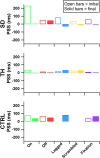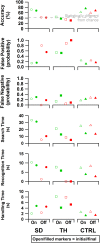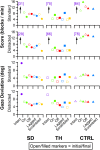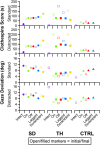Long-Term Home-Use of Sensory-Motor-Integrated Bidirectional Bionic Prosthetic Arms Promotes Functional, Perceptual, and Cognitive Changes
- PMID: 32140096
- PMCID: PMC7042391
- DOI: 10.3389/fnins.2020.00120
Long-Term Home-Use of Sensory-Motor-Integrated Bidirectional Bionic Prosthetic Arms Promotes Functional, Perceptual, and Cognitive Changes
Abstract
Cutaneous sensation is vital to controlling our hands and upper limbs. It helps close the motor control loop by informing adjustments of grasping forces during object manipulations and provides much of the information the brain requires to perceive our limbs as a part of our bodies. This sensory information is absent to upper-limb prosthesis users. Although robotic prostheses are becoming increasingly sophisticated, the absence of feedback imposes a reliance on open-loop control and limits the functional potential as an integrated part of the body. Experimental systems to restore physiologically relevant sensory information to prosthesis users are beginning to emerge. However, the impact of their long-term use on functional abilities, body image, and neural adaptation processes remains unclear. Understanding these effects is essential to transition sensate prostheses from sophisticated assistive tools to integrated replacement limbs. We recruited three participants with high-level upper-limb amputation who previously received targeted reinnervation surgery. Each participant was fit with a neural-machine-interface prosthesis that allowed participants to operate their device by thinking about moving their missing limb. Additionally, we fit a sensory feedback system that allowed participants to experience touch to the prosthesis as touch on their missing limb. All three participants performed a long-term take-home trial. Two participants used their neural-machine-interface systems with touch feedback and one control participant used his prescribed, insensate prosthesis. A series of functional outcome metrics and psychophysical evaluations were performed using sensate neural-machine-interface prostheses before and after the take-home period to capture changes in functional abilities, limb embodiment, and neural adaptation. Our results demonstrated that the relationship between users and sensate neural-machine-interface prostheses is dynamic and changes with long-term use. The presence of touch sensation had a near-immediate impact on how the users operated their prostheses. In the multiple independent measures of users' functional abilities employed, we observed a spectrum of performance changes following long-term use. Furthermore, after the take-home period, participants more appropriately integrated their prostheses into their body images and psychophysical tests provided strong evidence that neural and cortical adaptation occurred.
Keywords: human-machine interface; perceptual engineering; prosthesis; sensory restoration; take-home trial.
Copyright © 2020 Schofield, Shell, Beckler, Thumser and Marasco.
Figures












References
-
- Antfolk C., D’Alonzo M., Controzzi M., Lundborg G., Rosen B., Sebelius F., et al. (2013). Artificial redirection of sensation from prosthetic fingers to the phantom hand map on transradial amputees: vibrotactile versus mechanotactile sensory feedback. IEEE Trans. Neural Syst. Rehabil. Eng. 21 112–120. 10.1109/TNSRE.2012.2217989 - DOI - PubMed

